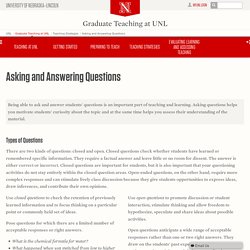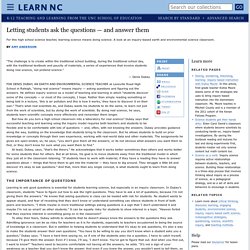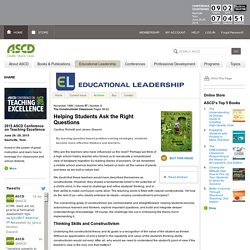

Asking and Answering Questions. Being able to ask and answer students' questions is an important part of teaching and learning.

Asking questions helps you motivate students' curiosity about the topic and at the same time helps you assess their understanding of the material. Types of Questions There are two kinds of questions: closed and open. Closed questions check whether students have learned or remembered specific information. They require a factual answer and leave little or no room for dissent.
Use closed questions to check the retention of previously learned information and to focus thinking on a particular point or commonly held set of ideas. Pose questions for which there are a limited number of acceptable responses or right answers. What is the chemical formula for water? These are all questions that anticipate certain answers to which students have already been exposed in a lecture, class activity, assigned reading, or some visual aid (video, web site, chart, demonstration). Strategies for Asking Questions. For Students, Why the Question is More Important Than the Answer. Thinkstock In a traditional classroom, the teacher is the center of attention, the owner of knowledge and information.

Teachers often ask questions of their students to gauge comprehension, but it’s a passive model that relies on students to absorb information they need to reproduce on tests. What would happen if the roles were flipped and students asked the questions? That’s the premise of the Right Question Institute and a new book by its co-directors Dan Rothstein and Luz Santana. The book, Make Just One Change: Teach Students to Ask Their Own Questions, documents a step-by-step process to help students formulate and prioritize questions about nearly everything. Coming up with the right question involves vigorously thinking through the problem, investigating it from various angles, turning closed questions into open-ended ones and prioritizing which are the most important questions to get at the heart of the matter. “We’ve been underestimating how well our kids can think.”
Bowkershort. Letting students ask the questions — and answer them. “The challenge is to create within the traditional school building, during the traditional school day, with the traditional textbook and paucity of materials, a series of experiences that involve students doing real science, not pretend science.” — Denis Dubay For Denis Dubay, an earth and environmental science teacher at Leesville Road High School in Raleigh, “doing real science” means inquiry — asking questions and figuring out the answers.

He defines inquiry science as a model of teaching and learning in which “students discover some of the concepts — or most of the concepts, I hope. Rather than simply reading something or being told in a lecture, ‘this is air pollution and this is how it works,’ they have to discover it on their own.” That’s what real scientists do, and Dubay wants his students to do the same, to learn not just from the work of scientists, but by doing the work of scientists.
But how do you turn a high school classroom into a laboratory for real science? The Right Way to Ask Questions in the Classroom. Updated 10/2013 Have you ever thought about how silly we teachers can be?

When we get in front of students, we present ourselves to be the ones with all the answers, and then after we talk to the students, we start asking questions as if we don't know anything we just talked about. No wonder students get confused! The Goal of a Question On a more serious note, as teachers, we need to come to grips with the fact that we really do not know everything, and there is no reason to assume that the students know nothing. There are a number of things to consider in this scenario. Harvard Education Publishing Group - Home. Students in Hayley Dupuy’s sixth-grade science class at the Jane Lathrop Stanford Middle School in Palo Alto, Calif., are beginning a unit on plate tectonics.

In small groups, they are producing their own questions, quickly, one after another: What are plate tectonics? How fast do plates move? Why do plates move? Do plates affect temperature? What animals can sense the plates moving? Far from Palo Alto, in the Roxbury neighborhood of Boston, Mass., Sharif Muhammad’s students at the Boston Day and Evening Academy (BDEA) have a strikingly similar experience. These two students—one in Palo Alto, the other in Roxbury—are discovering something that may seem obvious: When students know how to ask their own questions, they take greater ownership of their learning, deepen comprehension, and make new connections and discoveries on their own. Educational Leadership:The Constructivist Classroom:Helping Students Ask the Right Questions. Who are the teachers who have influenced us the most?

Perhaps we think of a high school history teacher who forced us to reevaluate a romanticized view of westward migration by reading diaries of pioneers. Or we remember a middle school science teacher who helped us learn all the names of plants and trees as we built a nature trail. We doubt that these teachers would have described themselves as constructivists. However, they shared a fundamental belief in the potential of a child's mind, in the need to challenge and refine students' thinking, and in their ability to make curriculum come alive.
The teaching world is filled with natural constructivists.